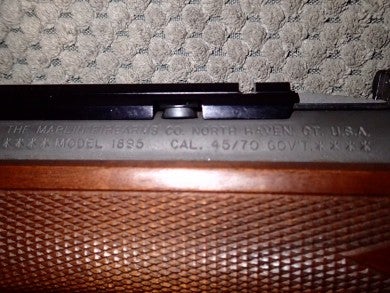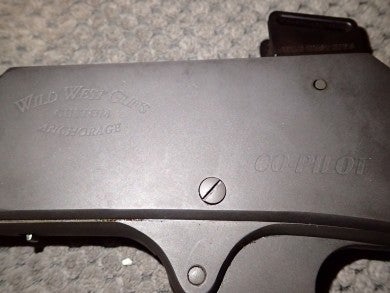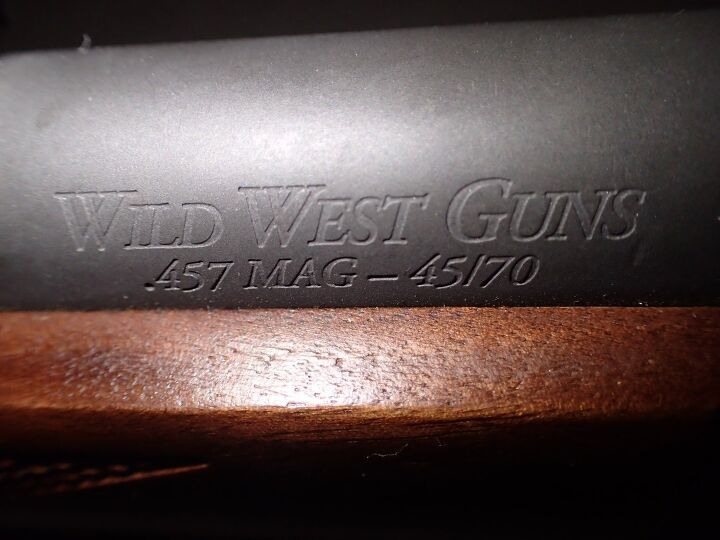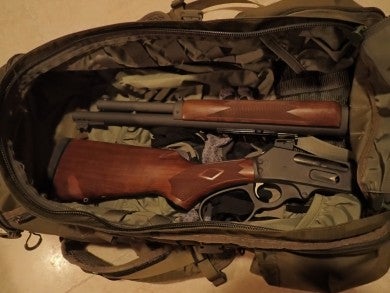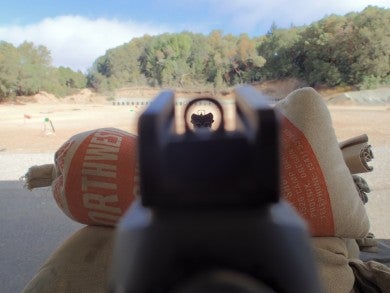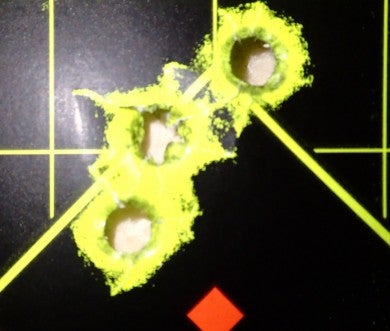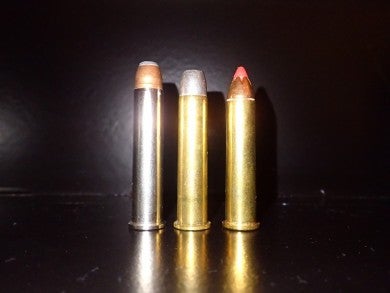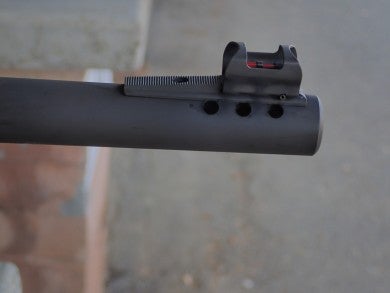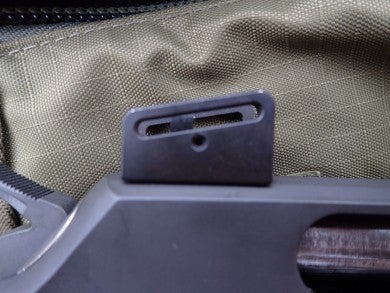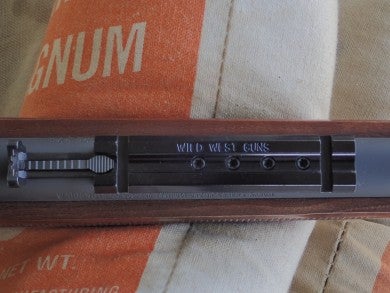Author’s note: I am aware Wild West Guns has a TV show, but I have not seen any of the episodes. This is purely a long-term review of one of their firearms.
A big-bore lever-action had been on my list of firearms I wished to acquire for quite some time when I happened across a WWG Alaskan Co-Pilot in .457WWG. It was in a rack in the pro shop of Gunsite. I handled it, worked the smooth lever action, and then tried the trigger. I was sold on it then and there, and acquired it via “cash on the barrelhead”, so to speak. Since then, it has been my go-to rifle for trips into areas where I know I could run into an ornery moose or bear around any corner.
Specs (I have an older model from 2007 and the specs and options have changed somewhat since I acquired mine):
- Built off of a Marlin 1895 Action
- 18.5″ Ported Barrel
- Able to chamber .457WWG, any .45-70 load including Buffalo Bore “magnum” cartridges, and .410 shotshells that are single loaded.
- Weight: 7lbs, 6.3oz
- Trigger pull: 3lbs as advertised with WWG “trigger happy kit”
- Breaks down to 19.25″
- Big loop lever
- 4+1 round capacity (current model can hold 6+1)
- Manganese Phosphate (Parkerized) finish
Range time:
There are a huge variety of loads available to fire from this rifle, as it can handle anything from low-velocity cowboy loads up to .457WWG or Buffalo Bore’s potent .45-70 Magnum loads. Recoil is managed exceptionally well due to the porting and Pachmayr Decelerator pad. Recoil from the cowboy loads is about at the level of a .22lr (non-existent), Hornady’s Leverevolution rounds feel like a .223, and the .457 Alaskan and Buffalo Bore Magnum loads feel pretty stout, about like a 12ga. It is during the follow-through on these loads that I really appreciate the big loop lever, as a standard lever would probably rap my knuckles. Even when shooting the heavier, faster loads, the rifle remains comfortable and handy. It points well and gets right back on target. One can cycle the bolt quickly and follow-up shots are facile. The “trigger happy kit” from WWG is a massive improvement in comparison to normal lever action triggers. The break is clean and crisp, and the trigger doesn’t wobble around all over the place like on my regular marlin. The safety clicks on and off nearly silently, with only 7 lbs of pressure required. Though being smooth and quiet, it stays in place either on or off safe. The lever itself is glassy smooth to operate. I can tell a ton of attention and craftsmanship was put into this rifle.
One of the main features of the Co-Pilot that sets it apart from other customized leverguns is that it has a takedown capability. To take it apart, unload and check the chamber, and with the bolt all the way rearward unscrew a knurled knob that connects the magazine tube to the barrel. Then you slide the magazine tube slightly forward. Then, rotate the barrel counterclockwise and pull forward. The whole process takes me about 30 seconds. I have not experienced any zero shift after breaking the rifle down and reassembling it.
There are two rear sights available to use: A ghost ring sight on the receiver and a foldable buckhorn sight on the barrel. The front sight post is fiber optic with a hood that is skeletonized to let light through while still providing excellent protection both from the ports and impacts to the sight. I prefer to use the ghost ring for the most part, though the buckhorn sight provides additional accuracy for longer-range shots with certain loads.
The rifle is advertised as having “minute of angle accuracy”, and I have verified that with some loads, even though I do not use an optic and the front sight covers a roughly 9″ diameter circle at 100 yards. Here is a sample of data entries from this rifle:
- Hornady .45-70 325gr FTX Leverevolution: zeroed at 100y w/ghost ring, 1.5in high at 50y, best group@100y .85in (the most consistently accurate load)
- Black Hills .45-70 405gr FPL “cowboy loads”: 5in low@100y w/ghost ring, zeroed at 50y, best group@100y 2in (lowest recoiling load)
- Buffalo Bore .45-70 Magnum 405grn JFN 3in low @100y w/ghost ring, zeroed at 50y, best group@100y 2.5in (heaviest recoiling load)
- HSM .457 WWG 405gr JFP, zeroed at 50y w/ghost ring, Best group@100y 2.65in (unfortunately, the most inconsistent load when it comes to accuracy)
Here is what I have found over time, load-wise:
The Hornady Leverevolution loads have been the best factory loads I have found for this rifle. The improved trajectory and accuracy has been a real asset, and I would be comfortable hunting out to 200 yards with this load. Recoil is not unpleasant at all. The Black Hills cowboy loads are the most pleasant to shoot all day long, though they do create quite a bit of fouling. The Buffalo Bore .45-70 Magnum loads are very hard-hitting, with muzzle energy of from an 18.5″ barrel at 50 yards of around 3000 ft/lbs. Recoil is very stout, however. These are the loads I carry when I am in moose or bear territory. Unfortunately, the .457 WWG loads from HSM are not up to the quality of this rifle. They sometimes print 4″ off of where I zeroed them to at 50y. The accuracy inconsistencies are unacceptable for anything other than range use. They were the only .457 loads available when I purchased the rifle, and I will not purchase them again. Thankfully, Cor-Bon makes .457WWG loads as of 2013 and I will get some when I’m done with this lot of HSM. The HSM and Buffalo Bore loads that are zeroed to 50y using the ghost ring sight will hit center at 100y when using the buckhorn sight. This is a nice added feature that makes hitting targets at different ranges a bit easier.
I have had zero failures to feed, fire, extract or eject in 8 years and approximately 2000 rounds. I have not noticed any degradation of the rifling or bore. The only rounds I have not fired from this rifle are .410 shotshells. The only issue that I have had is that the barrel accumulates copper fouling somewhat easily, so I usually take an extra cleaning step to remove such fouling every time I clean the barrel.
Time in the field:
I have carried this rifle both in a scabbard and sling on numerous long hikes in varying weather conditions. It has weathered snow, rain, mud, heavy dust, and fording rivers. It has never shown a bit of rust, despite being soaked a few times. The parkerizing has held up really well, with very few scratches despite contact with numerous rocks and branches. The wood has not shown any signs of warping, although it has a few nicks here and there. The front and rear sights have excellent protection, and have never been bent or bumped loose. The sights also stay right where I adjust them to. The muzzle is well protected as well due to the deep recessed crown, and has no dings or scrapes. The action has stayed smooth and operates well in below freezing temperatures without the need for special cold-weather grease or lubricant. The trigger, hammer, safety, and lever are all easy to feel and use even while wearing medium weight gloves. Being that I usually use a pack scabbard, I don’t break the Co-Pilot down very often. I can see it having utility in that I have seen hunters and other pilots have to strap their rifle to the wings of Super Cubs in Alaska due to limited interior space. If a rifle and case could be greatly lessened in length, one could fit inside of the aircraft cabin or other small cargo spaces. It also would be useful if one wanted a rifle along for general survival, and wanted to carry it in a standard backpack. One minor quibble I do have with the gun is that the scout scope base on the barrel is not a picatinny rail. This somewhat limits one’s options of an optic, as it does not accommodate as wide of a range of rings or optics as a 1913 rail would. If I change anything about this rifle going forward, I would like to put a tritium front and rear sight set on the gun, change the rail on the barrel out for a picatinny rail, and send the rifle in to have the new 6-round tube fitted.
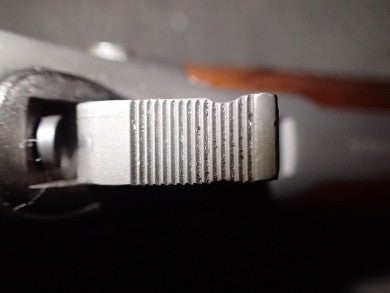
The hammer is nicely cut for extra purchase even while using gloves, and doesn’t make much noise when manually cocked
It should also be noted that Wild West Guns can customize your Co-Pilot should you order one, with SBR conversions also available.
Pros:
- Wide range of ammunition available gives it versatility
- Can handle .410 shotshells for extra survival utility
- 100% reliability thus far, even in adverse conditions
- Manages recoil well
- Outstanding trigger and action
- Takedown capability
- No zero shift from takedown and reassembly
- Lightweight and compact
- Solidly built, no broken parts as of yet
Cons:
- (minor) Requires a new sight base on the barrel or receiver to accommodate common red-dot sights or holosights
- Limited range for hunting purposes (about 200 yards maximum)
Overall, I have been extremely pleased with my purchase. It has been so many years that I do not remember exactly what I paid for the Co-Pilot (current MSRP is $2979.00), but I certainly do not have buyer’s remorse. If you currently have a Marlin 1895, you would be well served to send it off to WWG at the very least for a trigger and action job. Objectively, this rifle is accurate, reliable, and versatile. Subjectively, I feel confident in recommending this rifle to anyone needing a hard-hitting levergun, takedown or not. In the short ranges created by canyons and river bottoms where the willows get thick, it has the capability to put a charging bear or moose down fast. It is truly one of the best rifles I have had the pleasure of using at the range or in the field, and I’m glad to have it in my pack.
Thanks to Aaron Hughston Shooting School for technical assistance
 Your Privacy Choices
Your Privacy Choices

